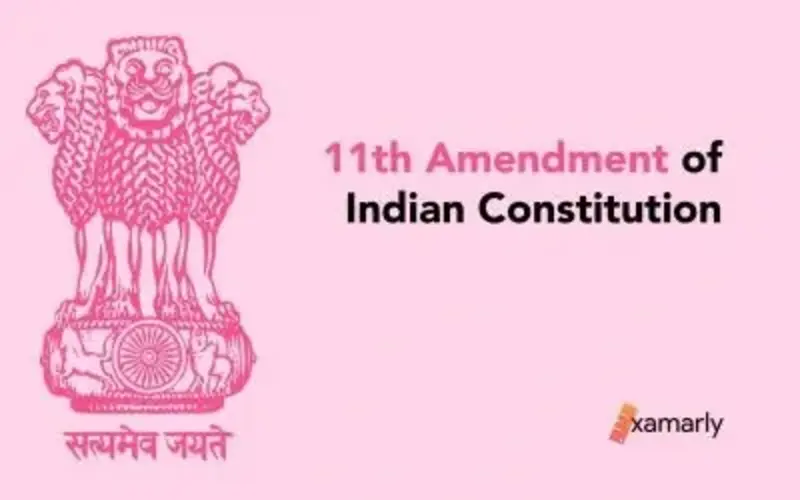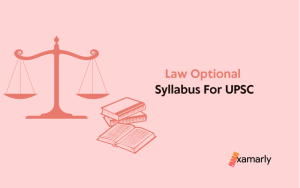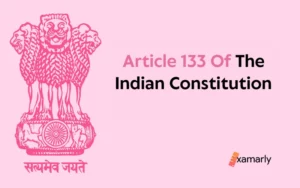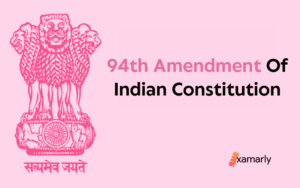The 11th amendment of the Indian Constitution is a lawful document. The vice presidential election is the purpose behind this. It is an Indian constitution part that was adopted by the Lok Sabha in November 1961. On December 19, 1961, it became effective.
This blog has curated important information about the 11th Amendment of the Indian constitution, especially for UPSC candidates. If you are preparing for polity, grab a note and write down the important points!
- Why Constitutional Amendments in India are Important?
- 11th Amendment of the Indian Constitution
- Objects and Reasons
- Amendments Modified by 11th CAA
- Enactment of the 7th CAA Bill
- Important Points to Remember
- Conclusion
- FAQs
- What Does Article 66(1) Say After The 11th Amendment?
- Can you explain what the 11th Amendment of the Indian Constitution is?
- What did the 11th Amendment of the Indian Constitution do?
- What was the need for the 11th Amendment to the Indian Constitution?
- Who proposed the 11th Amendment of the Indian Constitution?
- How many amendments are there in the Indian Constitution?
- Which Amendment abolished the Privy Council's jurisdiction?
Why Constitutional Amendments in India are Important?
Constitutional Amendments can address changes in the country’s social, political, and economic landscape. For example, the 73rd and 74th changes in 1992 aimed to strengthen local self-government and empower rural and urban local bodies to better serve the needs of their communities.
A constitutional Amendment can protect and expand the rights of citizens. Theycan modify the structure and function of the government, balancing power and promoting good governance.
11th Amendment of the Indian Constitution
The 11th Amendment of the Indian Constitution is also known as the Constitution Act of 1961.
It eliminates the prior need that members of both Houses of Parliament to meet together to elect the vice president.
Before this, members of both Houses of Parliament were required to assemble to elect the Vice-President. However, with this change, a new electoral college was created, which comprises members from both Houses of Parliament.
This means that the Vice-President can now be chosen by the members of this electoral college, and it is no longer necessary for them to assemble in one place to carry out the election process.
Objects and Reasons
- The Vice-President must be chosen by representatives of the Lower House and Upper House of Parliament gathered together at a joint sitting session per article 66(1) of the Constitution.
- This demand appears completely needless and could also pose practical challenges.
- Consequently, it is suggested that this article be changed to specify that the vice president would be chosen by members of an electoral college composed of representatives from both Houses of Parliament.
- In line with Article 54 of the Indian Constitution, a group of elected representatives from the state legislatures and the two Houses of Parliament makes up the electoral college that chooses the president.
- To meet the deadline for the presidential election, every possible attempt is made to ensure that such elections are completed beforehand.
- It may be probable that before the President or Vice-President is chosen, the elections for both Houses of Parliament could still be ongoing.
- To reflect the fact that the election of the Vice-President or President cannot be contested due to any ground of vacancy in the respective electoral college, regardless of the cause, it is advised that Article 71 be modified.
Amendments Modified by 11th CAA
This modified two articles of the Constitution: Article 66(1), and Article 71.
- The amendment of Article 66 involves the modification of Clause (1). It is no longer required for the members of both Houses of Parliament to meet together to elect the Vice-President.
- By the Indian Constitution, the Vice-President is elected through an electoral college consisting of members from both the House of Parliament.
- It adds a new clause (4) to Article 71 of the Constitution. It specifies that the election of the President or Vice President cannot be contested because there is a vacancy in the respective electoral college for whatever reason.
Similar Posts
- 69th Amendment of the Indian Constitution
- 58th Amendment of the Indian Constitution
- 57th Amendment of the Indian Constitution
Enactment of the 7th CAA Bill
Ashok Kumar Sen introduced the Constitution Bill in the Lok Sabha. It was 30 November on the calendar of 1961.
After profound discussions, on 5 December 1961, Lok Sabha passed the bill. On 12 December 1961, it paved its way through the Rajya Sabha. President Rajendra Prasad approved and enforced the bill on 19 December 1961.
Important Points to Remember
- The 11th Amendment was passed by the Indian Parliament and received presidential assent on August 1, 1961.
- The amendment made changes to Article 66 of the Constitution of India, which deals with the election of the Vice-President of India.
- Prior to this amendment, members of both Houses of Parliament (the Lok Sabha and the Rajya Sabha) had to meet together in one place to elect the Vice-President.
- With the 11th Amendment, a new electoral college was created for the election of the Vice-President. This electoral college comprises members of both Houses of Parliament, but they do not need to meet together in one place to carry out the election process.
- The electoral college for the Vice-President consists of members of the Lok Sabha, the Rajya Sabha, and the Legislative Assemblies of the states of India.
- The 11th Amendment also made some changes to the qualifications required for a person to be eligible for election as the Vice-President of India.
- The amendment also introduced a new schedule to the Constitution, which provides the details of the oath or affirmation that the Vice-President must take before assuming office.
Conclusion
The 11th Amendment of the Indian Constitution, also known as the Constitution Act of 1961, is a significant change that altered the process of electing the Vice-President of India.
By eliminating the requirement for members of both Houses of Parliament to physically meet together to elect the Vice-President, the amendment made the process more efficient and streamlined.
The creation of an electoral college consisting of members from both Houses of Parliament was a crucial step towards democratisation and inclusivity in the Indian political system.
FAQs
What Does Article 66(1) Say After The 11th Amendment?
The Vice-President will be chosen by members of an electoral college comprised of representatives of the House of Parliament using the single transferable vote and secret balloting in compliance with the proportional representation process.
Can you explain what the 11th Amendment of the Indian Constitution is?
The 11th Amendment of the Indian Constitution is a legal change that was made in 1961 and it plays a vital role in appointing the Vice president.
What did the 11th Amendment of the Indian Constitution do?
The 11th Amendment of the Indian Constitution changed the process of electing the Vice-President of India by creating an electoral college made up of members from both Houses of Parliament.
What was the need for the 11th Amendment to the Indian Constitution?
The 11th amendment of the Indian Constitution eliminated the need for members of both Houses of Parliament to physically meet to elect the Vice-President of India.
Who proposed the 11th Amendment of the Indian Constitution?
It was proposed by the Indian government and passed by both Houses of Parliament.
How many amendments are there in the Indian Constitution?
As of 2021, there are 104 changes to the Indian Constitution.
Which Amendment abolished the Privy Council’s jurisdiction?
The 7th Amendment to the Indian Constitution abolished the jurisdiction of the Privy Council.






